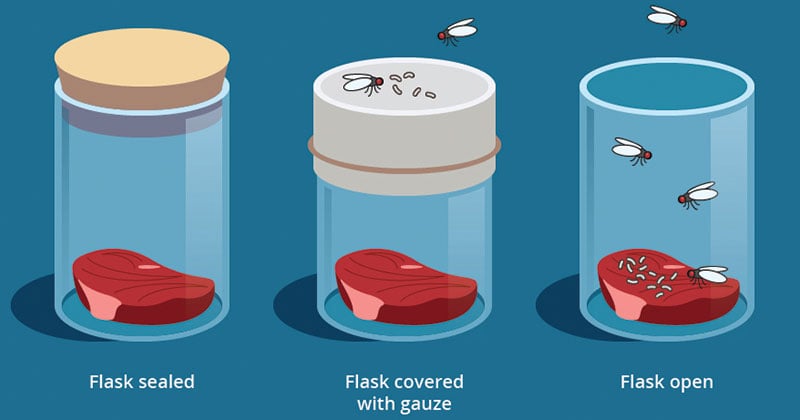- Spontaneous generation is an obsolete theory which states that living organisms can originate from inanimate objects.
- The theory believed that dust created fleas, maggots arose from rotting meat, and bread or wheat left in a dark corner produced mice among others.
- Although the idea that living things originate from the non-living may seem ridiculous today, the theory of spontaneous generation was hotly debated for hundreds of years.
- During this time, many experiments were conducted to both prove and disprove the theory.

Interesting Science Videos
Experiments in Support of Spontaneous Generation
The doctrine of spontaneous generation was coherently synthesized by Aristotle, who compiled and expanded the work of earlier natural philosophers and the various ancient explanations for the appearance of organisms, and was taken as scientific fact for two millennia.
Aristotle
- The Greek philosopher Aristotle (384–322 BC) was one of the earliest recorded scholars to articulate the theory of spontaneous generation, the notion that life can arise from nonliving matter.
- Aristotle proposed that life arose from nonliving material if the material contained pneuma (“vital heat”).
- As evidence, he noted several instances of the appearance of animals from environments previously devoid of such animals, such as the seemingly sudden appearance of fish in a new puddle of water.
John Needham
- The English naturalist John Turberville Needham was in support of the theory.
- Needham found that large numbers of organisms subsequently developed in prepared infusions of many different substances that had been exposed to intense heat in sealed tubes for 30 minutes.
- Assuming that such heat treatment must have killed any previous organisms, Needham explained the presence of the new population on the grounds of spontaneous generation.
Others
- By this time, the proponents of the theory cited how frogs simply seem to appear along the muddy banks of the Nile River in Egypt during the annual flooding.
- Others observed that mice simply appeared among grain stored in barns with thatched roofs. When the roof leaked and the grain molded, mice appeared.
- Jan Baptista van Helmont, a seventeenth century Flemish scientist, proposed that mice could arise from rags and wheat kernels left in an open container for 3 weeks.
Experiments against Spontaneous Generation
Though challenged in the 17th and 18th centuries by the experiments of Francesco Redi and Lazzaro Spallanzani, spontaneous generation was not disproved until the work of Louis Pasteur and John Tyndall in the mid-19th century.
Francesco Redi
- The Italian physician and poet Francesco Redi was one of the first to question the spontaneous origin of living things.
- Having observed the development of maggots and flies on decaying meat, Redi in 1668 devised a number of experiments, all pointing to the same conclusion: if flies are excluded from rotten meat, maggots do not develop. On meat exposed to air, however, eggs laid by flies develop into maggots.
- He tested the spontaneous creation of maggots by placing fresh meat in each of two different jars.
- One jar was left open; the other was covered with a cloth. Days later, the open jar contained maggots, whereas the covered jar contained no maggots.
- He did note that maggots were found on the exterior surface of the cloth that covered the jar. Redi successfully demonstrated that the maggots came from fly eggs.
Lazzaro Spallanzani
- The experiments of Needham appeared irrefutable until the Italian physiologist Lazzaro Spallanzani repeated them and obtained conflicting results.
- He published his findings around 1775, claiming that Needham had not heated his tubes long enough, nor had he sealed them in a satisfactory manner.
- Although Spallanzani’s results should have been convincing, Needham had the support of the influential French naturalist Buffon; hence, the matter of spontaneous generation remained unresolved.
Louis Pasteur
- Louis Pasteur‘s 1859 experiment is widely seen as having settled the question of spontaneous generation.
- He boiled a meat broth in a flask that had a long neck that curved downward, like that of a goose or swan.
- The idea was that the bend in the neck prevented falling particles from reaching the broth, while still allowing the free flow of air.
- The flask remained free of growth for an extended period. When the flask was turned so that particles could fall down the bends, the broth quickly became clouded.
- This work was so conclusive; that biology codified the “Law of Biogenesis,” which states that life only comes from previously existing life.
John Tyndall
- Support for Pasteur’s findings came in 1876 from the English physicist John Tyndall, who devised an apparatus to demonstrate that air had the ability to carry particulate matter.
- Because such matter in air reflects light when the air is illuminated under special conditions, Tyndall’s apparatus could be used to indicate when air was pure.
- Tyndall found that no organisms were produced when pure air was introduced into media capable of supporting the growth of microorganisms.
- It was those results, together with Pasteur’s findings, that put an end to the doctrine of spontaneous generation.
References
- Parija S.C. (2012). Textbook of Microbiology & Immunology.(2 ed.). India: Elsevier India.
- Sastry A.S. & Bhat S.K. (2016). Essentials of Medical Microbiology. New Delhi : Jaypee Brothers Medical Publishers.
- https://study.com/academy/lesson/spontaneous-generation-definition-theory-examples.html
- https://www.britannica.com/science/biology#ref498783
- https://www.infoplease.com/science/biology/origin-life-spontaneous-generation
- https://www.allaboutscience.org/what-is-spontaneous-generation-faq.htm
- https://courses.lumenlearning.com/microbiology/chapter/spontaneous-generation/
